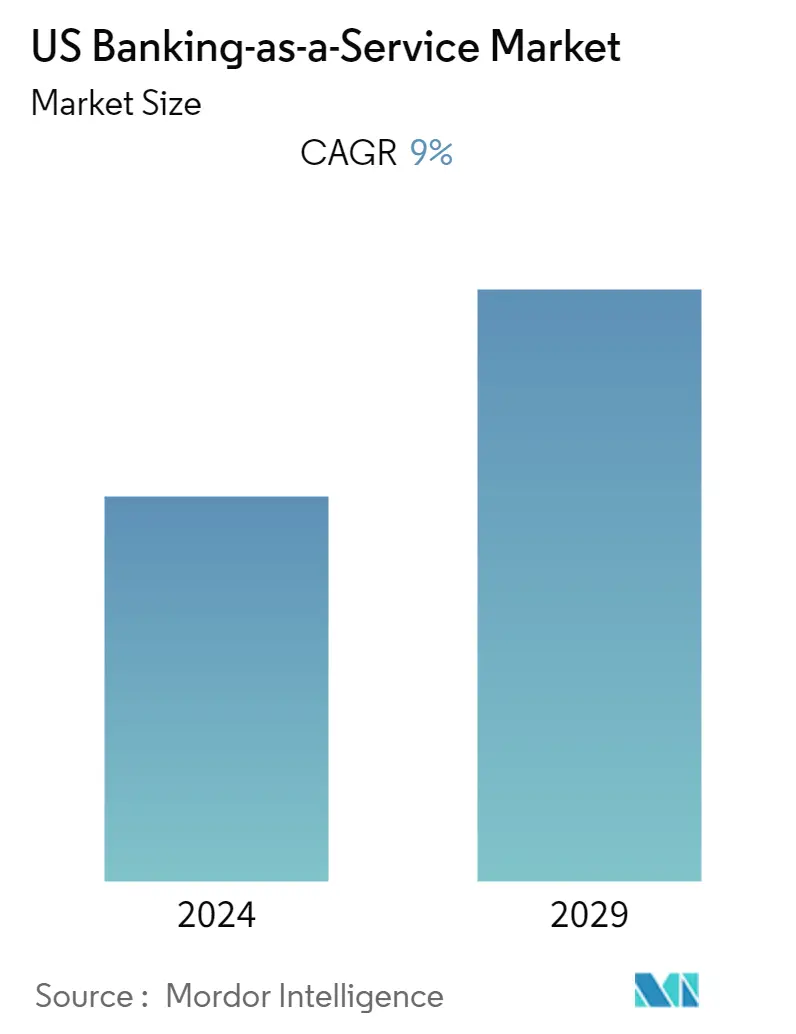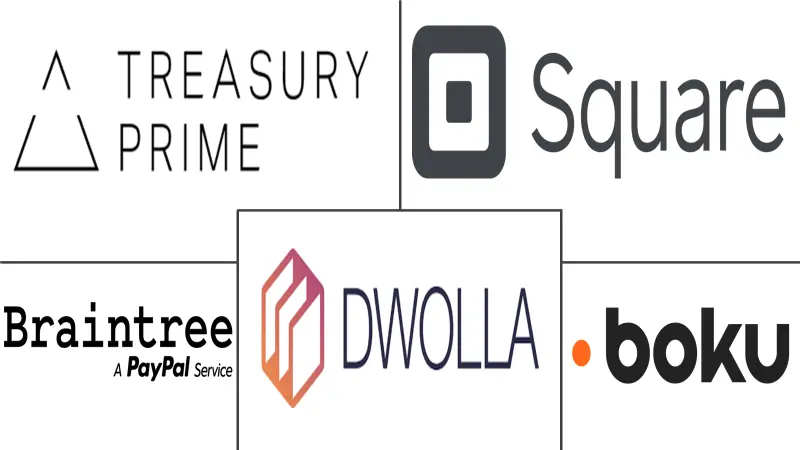| Study Period | 2020 - 2029 |
| Base Year For Estimation | 2023 |
| Forecast Data Period | 2024 - 2029 |
| Historical Data Period | 2020 - 2022 |
| CAGR | 9.00 % |
| Market Concentration | Medium |
Major Players*Disclaimer: Major Players sorted in no particular order |
US Banking-as-a-Service Market Analysis
The Covid-19 pandemic has resulted in increased adoption of Banking-as-a-Service for non-banking businesses. People have progressively utilized e-commerce platform solutions during the epidemic, resulting in an increase in online payment technologies. Financial institutions have demonstrated a strong interest in banking as a service to improve business processes and deliver secure contactless payments since the Pandemic.
Banking-as-a-Service Market systems have evolved as a key component of open banking, which allows third parties to establish new services using banks' application programming interfaces (APIs), providing account holders with more financial transparency options. This technology is revolutionizing retail banking, redefining incumbents' customer relationships, and making it easier for fintech to enter the market. The need for banking-as-a-service (BaaS) platforms is rapidly increasing in the United States, owing to the country's expanding financial market and expanding insurance industries. Digital banking in the United States has undergone substantial transformation and expansion in recent years, with over 70 digital banking platforms introduced since 2018, fueling the growth of BaaS platforms in the country. The demand for banking-as-a-service (BaaS) platforms in the United States is predicted to grow at a rapid rate over the forecast period. Big data, platform business models, advanced analytics, smartphone technology, and peer-to-peer networks are rapidly driving the US economy. At the same time, financial sector innovation is transforming the market drastically.
Application programming interfaces (APIs) have proven to be a lifesaver for banks, since they have simplified digital transitions and allowed for faster pivots and innovations. FinTechs and other third-party service providers (TPSP) can assist banks provide consumers with a transparent, smooth, and tailored financial service in addition to their conventional banking services by using APIs which will further increase the demand for banking-as-a-service in the future.
US Banking-as-a-Service Industry Segmentation
Banking as a Service (BaaS) is a paradigm in which licensed banks incorporate their digital banking services directly into non-bank firms' products. This allows non-bank businesses to provide digital banking services to their consumers, such as mobile bank accounts, debit cards, loans, and payment services, without having to obtain their own banking license. This report aims to provide a detailed analysis of the US Banking-as-a-Service Market. It focuses on the market dynamics, emerging trends in the segments, the future of markets, and insights on various drivers and restraints. Also, it analyses the key players and the competitive landscape in the market. US Banking-as-a-Service Market can be segmented By Component (Platform and Service (Professional Service and Managed Service)), by Type (API based BaaS and Cloud-based BaaS), By Enterprise Size (Large enterprise and Small & Medium enterprise), By End-user (Banks, NBFC/Fintech Corporations and Others).
| Platform | |
| Services | Professional Service |
| Managed Service |
| API Based BaaS |
| Cloud Based BaaS |
| Large Enterprise |
| Small and Medium Enterprise |
| Banks |
| Fintechs Corporations/NBFC |
| Others |
US Banking-as-a-Service Market Size Summary
The Banking-as-a-Service (BaaS) market in the United States is experiencing significant growth, driven by the increasing adoption of digital banking solutions and the evolving landscape of open banking. The Covid-19 pandemic accelerated the shift towards e-commerce and online payment technologies, prompting financial institutions to explore BaaS to enhance business processes and offer secure, contactless payment options. BaaS has become a crucial element of open banking, enabling third-party developers to create new services using banks' APIs, thereby enhancing financial transparency and customer engagement. This technological advancement is reshaping retail banking, fostering stronger relationships between incumbents and customers, and facilitating easier market entry for fintech companies. The expanding financial and insurance sectors in the U.S. are further propelling the demand for BaaS platforms, which have seen substantial growth with the introduction of numerous digital banking platforms since 2018.
The BaaS model offers non-banking and fintech organizations the opportunity to provide online banking services without the need for bank licenses or regulatory compliance, allowing them to focus on core business activities. This model is particularly appealing to industries such as airlines, which can offer digital banking services like mobile accounts and payment solutions. The use of APIs has been instrumental in simplifying digital transitions for banks, enabling faster innovation and enhancing customer service offerings. Banks are increasingly leveraging APIs to share data with third-party financial organizations, creating new revenue streams and fostering partnerships with fintech companies. The competitive landscape of the BaaS market is characterized by a diverse range of players seeking to differentiate themselves through service offerings, reputation, and scalability. Recent venture capital investments have further strengthened the market position of BaaS companies, with U.S.-based firms expanding their presence globally.
US Banking-as-a-Service Market Size - Table of Contents
1. MARKET SEGMENTATION
-
1.1 By Component
- 1.1.1 Platform
- 1.1.2 Services
- 1.1.2.1 Professional Service
- 1.1.2.2 Managed Service
-
1.2 By Type
- 1.2.1 API Based BaaS
- 1.2.2 Cloud Based BaaS
-
1.3 By Enterprise
- 1.3.1 Large Enterprise
- 1.3.2 Small and Medium Enterprise
-
1.4 By End User
- 1.4.1 Banks
- 1.4.2 Fintechs Corporations/NBFC
- 1.4.3 Others
US Banking-as-a-Service Market Research FAQs
What is the current US Banking-as-a-Service Market size?
The US Banking-as-a-Service Market is projected to register a CAGR of 9% during the forecast period (2025-2030)
Who are the key players in US Banking-as-a-Service Market?
Braintree, BOKU, Dwolla, Square Inc and Treasury Prime are the major companies operating in the US Banking-as-a-Service Market.




